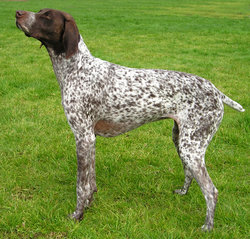
Deutsch Kurzhaar
DK
|
From Wikipedia the free encyclopedia, by MultiMedia |
| German Shorthaired Pointer | ||
|---|---|---|

This liver-and-white German Shorthaired Pointer has a
ticked coat and a patched head.
|
||
| Alternative names | ||
| Deutscher kurzhaariger Vorstehhund Deutsch Kurzhaar |
||
| Country of origin | ||
| Germany | ||
| Common nicknames | ||
| GSP DK |
||
| Classification and breed standards | ||
| FCI: | Group 7 Section 1 #119 | |
| AKC: | Sporting | |
| ANKC: | Group 3 (GunDogs) | |
| CKC: | Group 1 - Sporting Dogs | |
| KC (UK): | GunDog | |
| NZKC: | GunDog | |
| UKC: | Gun Dog Breeds | |
| Not recognized by any major kennel club | ||
| This breed of Dog is extinct | ||
| Notes | ||
The German Shorthaired Pointer is a breed of Dog developed in the 1800s in Germany for hunting. This gun Dog was developed by crossing an older German Pointer breed with the English Pointer to create a lean, athletic, and responsive breed. Some authorities consider it to be the most versatile of all gun Dogs and its intelligence and affectionate nature make it a popular companion Dog for active owners.
The German Shorthaired Pointer's coat is short, flat, thick, and harsh. It is dense enough to be water-resistant. The color can be liver (often called chestnut), black (although any area of black is cause for disqualifiction in American Kennel Club and Canadian Kennel Club sanctioned shows), or either color with white. Commonly the head is a solid or nearly solid color and the body is white that is speckled or ticked with liver or black, with saddles or large patches of solid color. Roan coats also occur and, rarely, yellow coloring (Dogs with any area of yellow will also be disqualified in AKC and CKC shows).
It has moderately long flop ears set high on the head. Its muzzle is long, broad, and strong, allowing it to retrieve even heavy furred game. Its tail is commonly docked, although this is now prohibited in some countries.
The breed is lean, athletic, and graceful yet powerful, with strong hindquarters that make it able to move rapidly and turn quickly. Various breed standards set its height at the withers anywhere between 21 and 26 inches (53 to 65 cm), making this a large breed. Adults typically weigh from 55 to 70 lbs (25 to 32 kg), with the bitch usually slightly shorter and lighter than the male.
This variety of German Pointer can be shy; however, it is usually good with children and is affectionate and loyal, making it a good companion Dog. These Dogs crave interaction and have been referred to as "velcro Dogs" often needing to be in physical contact with a member of their human family or very nearby, sometime almost underfoot. It needs plenty of vigorous activity, so it is not a good pet for an inactive home. The breed generally gets along well with other Dogs. Some Shorthaired Pointers make good watchDogs, but others are too good-natured.
Like the other German Pointers—the German Wirehaired Pointer and the German Longhaired Pointer—this is one of the few hunting breeds that can perform virtually all gunDog roles. It is pointer and retriever, bird Dog and water Dog, can be used for hunting larger and more dangerous game, and in addition has a scent hound's talented nose. It is an excellent swimmer but also works well in rough terrain. It is tenacious, tireless, hardy, and reliable. In short, it is a superb all-around field Dog that remains popular with hunters of many nationalities.
This is an intelligent and trainable breed. Like most intelligent Dogs, it can have a mind of its own and so the breed requires training to ensure that it understands that the owner is in charge. Along with its superb hunting ability and companionable personality, its intelligence and biddability (trainability) continue to make this one of the more popular large breeds.
The Shorthaired Pointer is generally a healthy breed. Seizures have been a problem in some lines, and a few individuals may suffer from hip dysplasia, genetic eye diseases, or skin cancer. Like all Dogs with flop ears, it can be prone to ear infections and its ears require regular checking and cleaning. It has a longer life expectancy than many breeds of this size, commonly living 12 to 14 years.
Its short coat needs very little grooming, just occasional brushing. The Dog should be bathed only when needed.
As it is a large, active breed, it can require considerable food; however, it can also become obese if too much food is given for its activity level.
The German Shorthaired Pointer is descended from the old Spanish Pointer, which was taken to Germany in the 1600s. From that time until the first studbook was created in 1870, however, it is impossible to identify all of the Dogs that went into creating this breed. Most-likely candidates for its ancestors include local German breeds such as other hunting Dogs and scent hounds, the Bloodhound, the Foxhound, various French hounds, assorted Scandinavian breeds, the German Bird Dog, and the Italian Pointer. In the late 1800s, breeders added the English Pointer to the lines, rounding out the breed's all-around utility.
On February 15, 2005, a German Shorthaired Pointer, "Ch Kan-Point's VJK Autumn Roses" (callname Carlee), took the Westminster Kennel Club Dog Show's prize for Best in Show.
Breed clubs:
Dogs, made by MultiMedia | Free content and software
This guide is licensed under the GNU Free Documentation License. It uses material from the Wikipedia.